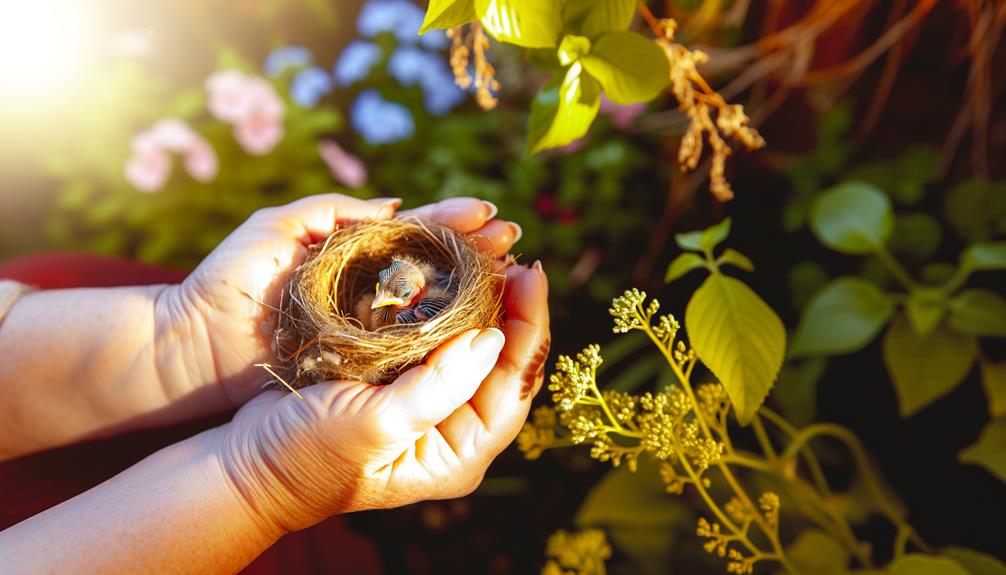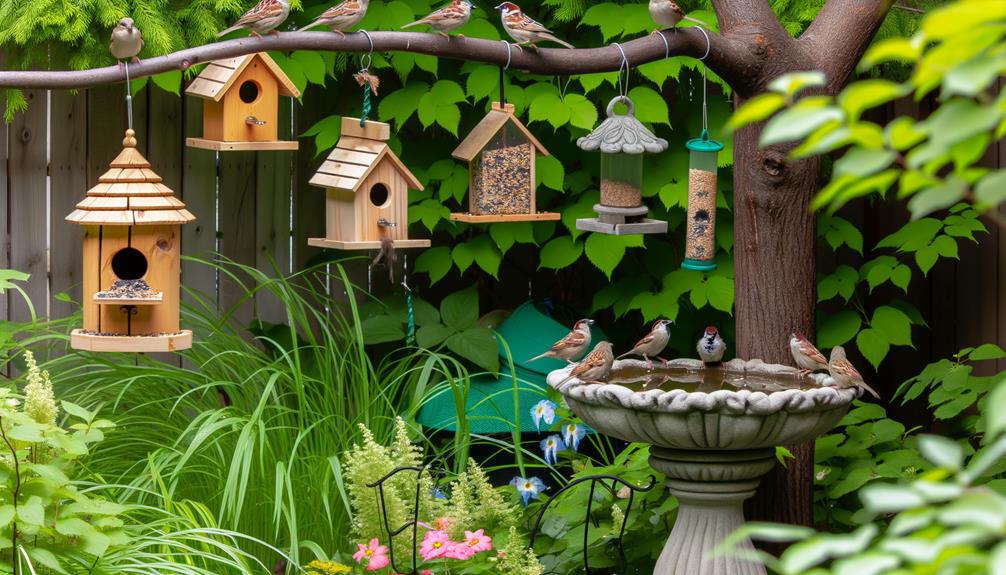How You Can Care for and Domesticate a Baby Sparrow
You can domesticate a baby sparrow, but it demands careful attention and understanding of its natural behavior. Sparrows need a high-protein diet, regular feeding every 20-30 minutes from dawn till dusk, and a habitat mimicking their natural environment.
Legal and ethical considerations are essential; check for required permits and wildlife regulations in your area. Engage in regular socialization to mimic their communal nature and guarantee their physical well-being.
Monitoring health, sanitation, and providing enrichment activities are vital to prevent stress and illness. Explore expert care routines and potential legal requirements for a thorough understanding.

Key Takeaways
- Domestication requires replicating their natural habitat to ensure security and comfort.
- Legal regulations may require permits; consult local wildlife agencies.
- Baby sparrows need a high-protein diet of insects and seeds.
- Regular socialization is crucial for behavioral development.
- Consider alternatives like wildlife rehabilitation centers for ethical care.
Understanding Sparrow Behavior

To effectively domesticate a baby sparrow, it's important to first understand their natural behavior patterns, including their social interactions, feeding habits, and daily routines.
Sparrows are inherently social creatures, often engaging in communal activities such as foraging and preening. You'll notice they rely heavily on vocal communication, using distinct calls to convey various needs and emotions.
Nutritionally, baby sparrows require a high-protein diet, typically consisting of insects and seeds, which you must replicate precisely.
Their daily routines include periods of active foraging followed by rest and grooming. Observing these behaviors can help you create an environment that mimics their natural habitat, fostering a sense of security and comfort.
This understanding will enable you to cater to their specific needs effectively.
Legal Considerations
Before attempting to domesticate a baby sparrow, you must familiarize yourself with local wildlife regulations to guarantee compliance with legal requirements. Many regions have strict laws protecting native bird species.
To make sure you're on the right side of the law:
- Check Permits: Determine if you need a special permit to keep a sparrow, as many species are protected under the Migratory Bird Treaty Act.
- Understand Restrictions: Some areas may forbid capturing or keeping wild birds, making it essential to know your jurisdiction's specific rules.
- Consult Authorities: Reach out to local wildlife agencies or rehabilitation centers for guidance and clarification on legal matters.
Ethical Implications

While abiding by legal requirements is crucial, you must also consider the ethical implications of domestication to safeguard the well-being and natural behaviors of the baby sparrow are respected. Capturing and domesticating a wild animal can disrupt its inherent instincts. You should question if human intervention truly benefits the bird.
| Ethical Consideration | Description | Actionable Steps |
|---|---|---|
| Natural Behavior | Preserve innate behaviors | Provide environment mimicking natural habitat |
| Physical Health | Guarantee physical well-being | Regular health checks, balanced diet |
| Psychological Health | Prevent stress and behavioral issues | Enrichment activities, social interaction |
| Environmental Impact | Impact on local ecosystem | Assess ecosystem before domesticating |
| Long-term Welfare | Sustainability of domestication effort | Plan for lifelong care, avoid abandonment |
Prioritizing these ethical considerations guarantees you are serving the bird's best interests.
Basic Care Requirements
To properly care for a baby sparrow, you'll need to focus on three critical aspects: feeding, housing, and socialization.
Guarantee you're providing a nutrient-rich diet suitable for its developmental stage, set up an ideal cage that mimics its natural habitat, and engage in consistent socialization to facilitate behavioral training.
Each of these components is essential for promoting the bird's health and well-being.
Feeding Young Sparrow
Feeding a young sparrow involves providing a high-protein diet, such as soaked cat kibble or specially formulated bird food, to meet its rapid growth needs. Make sure the food is soft and easily digestible.
Here's a concise feeding guide:
- Frequency: Feed the baby sparrow every 2-3 hours during daylight. This mimics their natural feeding pattern.
- Portions: Offer small, bite-sized portions to prevent choking. Monitor the bird's crop to avoid overfeeding.
- Hydration: Maintain hydration with a few drops of water via a syringe, but avoid over-watering to prevent aspiration.
Always observe the bird's behavior and health closely. Adjust feeding techniques based on its response and developmental stage, promoting optimal growth and well-being.
Ideal Cage Setup
Creating an ideal cage setup for a baby sparrow necessitates careful attention to its environmental needs, guaranteeing safety, comfort, and developmental support.
Begin with a spacious cage, at least 18x18x24 inches, to allow ample movement. Line the bottom with soft bedding to cushion falls and absorb waste. Install perches of varying diameters to promote foot health and muscle development. Provide a shallow dish for bathing, essential for feather maintenance.
Maintain a stable temperature around 75°F, avoiding drafts and direct sunlight. Use a mesh cover to prevent escapes while allowing ventilation. Incorporate natural elements like branches and leaves to simulate a wild habitat.
Lastly, make sure access to clean water and fresh food, placed in easily accessible dishes.
Socialization and Training
Socializing and training a baby sparrow involves consistent interaction to foster trust, utilizing gentle handling and positive reinforcement techniques. Prioritize regular, short sessions to minimize stress.
Here's a structured approach:
- Daily Interaction: Spend at least 15 minutes each day engaging with the sparrow. This promotes familiarity and reduces fear.
- Hand-Feeding: Offer food directly from your hand to create a positive association. Use small insects or sparrow-specific seed mixes.
- Vocal Mimicry: Imitate sparrow calls to communicate effectively. This technique strengthens the bond and aids in vocal recognition.
Feeding a Baby Sparrow

You'll need to provide a diet rich in protein and nutrients, mimicking what sparrows eat in the wild. Offer a combination of moistened dog or cat kibble, hard-boiled egg yolk, and mealworms.
Ensuring you feed every 20 to 30 minutes from dawn till dusk is crucial. Carefully monitor the chick's growth and adjust the feeding schedule as it matures.
Suitable Food Choices
Feeding a baby sparrow demands careful attention to its nutritional needs, important for a diet rich in proteins, fats, and essential vitamins to support its rapid growth and development.
You should focus on the following food choices:
- Insect Protein: Offer finely crushed insects such as mealworms, which provide ample proteins important for muscle development.
- Egg Yolk Mixture: A blend of hard-boiled egg yolk and water offers essential fats and vitamins, promoting feather growth and overall health.
- Commercial Hand-Feeding Formula: Specially formulated for baby birds, this is important for a balanced intake of all necessary nutrients.
Feeding Schedule Guidelines
To maximize growth and health, a careful feeding timetable is crucial for a baby sparrow, providing frequent, small meals throughout the day to mirror the natural feeding patterns observed in the wild. You should aim to feed the chick every 20-30 minutes from sunrise to sunset. This schedule aligns with the high metabolic demands of a growing sparrow.
Use a small syringe or tweezers to deliver the food directly into the bird's mouth. Make sure the food is at room temperature to prevent digestive issues.
As the sparrow matures, gradually extend the intervals between feedings. By six weeks, it should be eating every two to three hours. This systematic approach ensures prime development and health.
Health and Safety Issues
Ensuring the health and safety of a baby sparrow requires meticulous attention to its environment, diet, and handling practices.
You must create a stable, hygienic habitat to prevent stress and disease. Monitor dietary intake carefully; offer nutrient-rich foods that mimic their natural diet.
When handling, minimize contact to reduce stress and potential for injury.
Follow these three key practices for excellent care:
- Sanitation: Regularly clean the habitat to eliminate pathogens and waste.
- Nutrition: Provide a balanced diet including insects and specialized bird formula.
- Observation: Frequently check for signs of illness or distress like lethargy, changes in eating habits, or abnormal droppings.
Alternatives to Domestication

Consider releasing the baby sparrow into a wildlife rehabilitation center where experts can provide specialized care and prepare it for a successful return to its natural habitat. This approach not only safeguards the bird's well-being but also contributes to ecological balance. Rehabilitation centers utilize scientifically-backed methods to ensure birds develop essential survival skills.
Here's a comparison of various alternatives:
| Alternative | Pros | Cons |
|---|---|---|
| Wildlife Rehabilitation Center | Expert care, natural habitat reintegration | Limited availability, potential costs |
| Specialized Avian Sanctuaries | Safe environment, species-specific care | Permanent captivity, limited interaction |
| Local Wildlife Organizations | Community-based support, volunteer options | Variable expertise, potential overcrowding |
| Backyard Bird-Friendly Habitats | Personal involvement, local ecosystem boost | Limited care, potential predation risk |
| Partnering with Ornithologists | Scientific guidance, conservation support | Limited personal involvement |
Each option has distinct benefits and challenges, ensuring the sparrow's best interests are prioritized.
Conclusion
To sum up, while you might be tempted to domesticate a baby sparrow, it's fraught with ethical, legal, and practical challenges. Scientific observations reveal these birds thrive best in their natural habitats.
Instead of attempting domestication, consider alternatives like supporting wildlife rehabilitation centers. These avenues guarantee the sparrow's well-being while respecting ecological balance.
Ultimately, prioritizing their natural behavior and habitat is the most ethical and scientifically sound approach.






